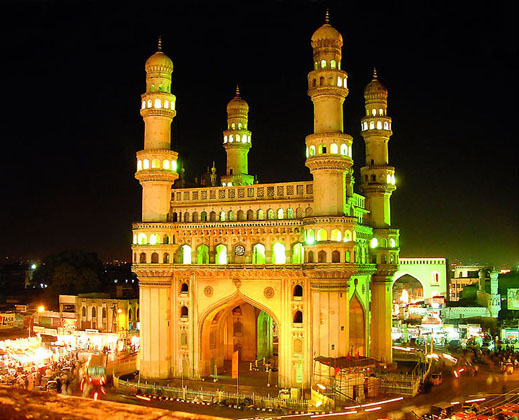
The Pew report “Mapping the Global Muslim Population: A Report on the Size and Distribution of the World’s Muslim Population,” concluded that the world wide Muslim population was 1.6 billion and that the majority of Muslims today reside beyond the birth place of Islam. It is estimated that over 30% of Muslims – the largest – reside in Hind, which comprised of India, Pakistan and Bangladesh.
Contact between the Muslims from Baghdad – the Abbasid Khilafah [800-1300 CE] – took place before the expedition of Muhammed bin Qasim, which has come to be seen as a seminary period in the regions history books. The Arabs used to visit the coast of Southern India, which then provided the link between the ports of South and South East Asia. After the Arab traders became Muslim, they brought Islam to South Asia. A number of local Indians living in the coastal areas embraced Islam through contact with the Muslim traders.
Over a period of 500 years Islam expanded across the Indus plains. By the 12th century Islam had reached Delhi. The Islamic conquests were different compared to the previous invasions into the region, as many conquerers did nothing regarding the prevailing customs and in many cases assimilated into the existing architecture. Hind had an abhorrent caste system which differentiated between people on ethnic lines which led to the supremacy of princely rulers who enslaved many to work in their fields in return for basic wages. As Hindu and Buddhist kingdoms came under the fold of Islam, the Khilafah became a highly centralising force that facilitated the creation of a common legal system that gradually replaced the caste system.
Letters of credit issued in Egypt or Tunisia were honoured in India and in order to create and sustain such an internationally consistent legal system, local and traditional systems of governance were uprooted.
In an analysis of the Muslim conquest of the Indian subcontinent, one researcher highlighted: “Unlike earlier conquerors who assimilated into prevalent social systems, Muslim conquerors retained their Islamic identity and created legal and administrative systems that challenged and destroyed existing systems of social conduct, culture, religious practices, lifestyle and ethics.”[i]
The Muslims when they came to the region introduced a new culture, which was very different from the existing cultures. Muhammad bin Qasim set up an administrative structure that incorporated a newly conquered land, inhabited by non-Muslims. He adopted a conciliatory policy, asking for acceptance of Muslim rule by the natives in return for non-interference in their religious practices, so long as the natives paid Jizya, without forced conversion. Shari’ah law was applied over the people of the region; however, Hindus were allowed to settle their marital disputes according to their own laws. Hindus and Buddhists were inducted into the administration as trusted advisors and governors.[ii] A Hindu, was at one point the second most important member of Muhammed bin Qasim’s administration.[iii]
Islam created a system where political power, law and worship became fused in a manner so as to safeguard the interests of all people. This stability led to the subcontinent to become the hub between the Far East and the Mediterranean. The Khilafah has also been credited for creating the Karkhanas – small factories in the subcontinent. New towns were created that specialised in a particular category of manufactured goods, which led to development and prosperity that had not been seen for centuries.
While the spread of Islam in the Sub-continent is the story of untiring efforts of numerous saints and Sufis who dedicated their lives to the cause of Islam, by the time the Muslims conquered Delhi and established what came to be known as the Delhi Sultanate, Sufi fraternities had come into being and the Sufi influence was far more powerful than it was in earlier days under the Arabs in Sindh.
One Hindu historian described this period as follows: “Throughout its existence the Delhi Sultanate (1205-1526), remained a legal part of the worldwide Muslim empire functioning under the de jure suzerainty of the Abbasid caliphs. Sultans considered themselves the deputies of the caliph and derived their validity of their administrative and legal authority only on the basis of delegation. Since the supreme authority of the community legally remained with the caliph, every king and potentate claimed to exercise governmental power for, and on behalf of the Imam of Islam.”[iv]
In this way many people who were discriminated against due to the caste system embraced Islam.
It was only the weakness that overcame Muslims in understanding Islam that became the cause of their decline as under Islam the people of the region only saw progress.
Hind today
Today, Hind is widely, though incorrectly, recognised as encompassing India alone. In spite of the apparent economic growth of India today, the region is the most poverty stricken in the world after Africa. The resources of the region have not been marshalled for the people and corruption runs rampant as it was before Islam came to the region.
We also unfortunately see the ancient caste system return to the region which has turned the region into hereditary groups creating huge fault-lines which has led to the ugly head of sectarianism returning to the region when the early Muslims dedicated their lives to removing it.
The Hind region today is a far cry from the heights it achieved in the past.
Adnan Khan
i M. S. Asimov and C. E. Bosworth, ‘History of Civilizations of Central Asia,’ Vol IV: The Rise of Islam and Nomadic
and Military Empires in Central Asia, Paris: UNESCO Publishing, 1998
ii Nicholas F. Gier, FROM MONGOLS TO MUGHALS: RELIGIOUS VIOLENCE IN INDIA 9TH-18TH CENTURIES, Presented at the Pacific Northwest Regional Meeting American Academy of Religion, Gonzaga University, May, 2006 http://www.class.uidaho.edu/ngier/mm.htm
iii H. M. Elliot and John Dowson, The History of India as Told by Its Own Historians, (London, 1867-1877), vol. 1, p. 203.
iv Shashi S. Sharma, Caliphs and Sultans – Religious ideology and political praxis, pg. 247
